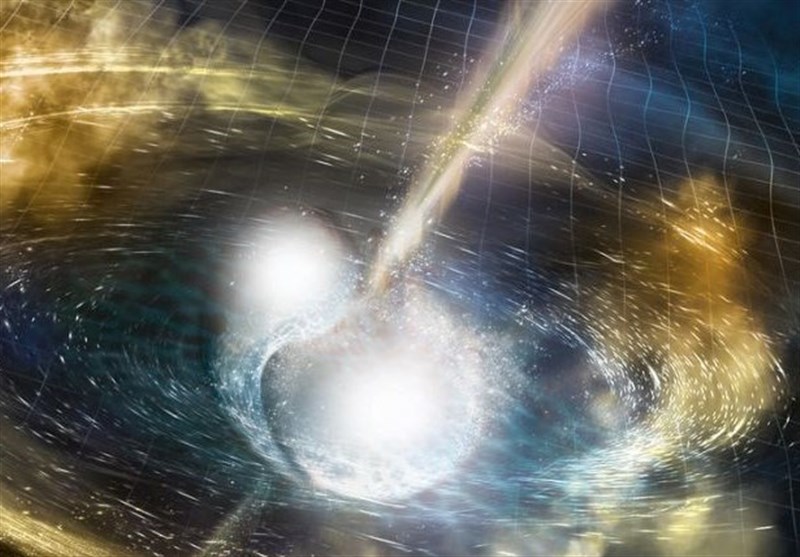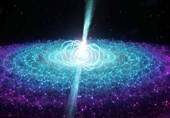Missing-Link Atoms Turn Up in Aftermath of Neutron-Star Collision
TEHRAN (Tasnim) – Two neutron stars smashed together and shook the universe, triggering an epic explosion called a "kilonova" that spit lots of ultradense, ultrahot material into space.
Now, astronomers have reported the most conclusive evidence yet that in the aftermath of that blast a missing-link element formed that could help explain some confusing chemistry of the universe.
When that shaking — ripples in the very fabric of space-time, called gravitational waves — reached Earth in 2017, it set off gravitational-wave detectors and became the first neutron- star collision ever detected Immediately, telescopes all over the world whirled around to study the light of the resulting kilonova. Now, data from those telescopes has revealed strong evidence of strontium whirling in the expelled matter, a heavy element with a cosmic history that was difficult to explain given everything else astronomers know about the universe.
Earth and space are littered with chemical elements of different kinds. Some are easy to explain; hydrogen, made up in its simplest form of just one proton, existed soon after the Big Bang as subatomic particles began to form. Helium, with two protons, is pretty easy to explain as well. Our sun produces it all the time, smashing together hydrogen atoms through nuclear fusion in its hot, dense belly. But heavier elements like strontium are more difficult to explain. For a long time, physicists thought these hefty elements mostly formed during supernovas — like kilonova but on a smaller scale and resulting from the explosion of massive stars at the ends of their lives. But it's become clear that supernovas alone can't explain how many heavy elements are out there in the universe.
Strontium turning up in the aftermath of this first detected neutron-star collision could help confirm an alternative theory, that these collisions between much smaller, ultradense objects actually produce most of the heavy elements we find on Earth.
Physics doesn't need supernovas or neutron-star mergers to explain every chunky atom around. Our sun is relatively young and light, so it mostly fuses hydrogen into helium. But bigger, older stars can fuse elements as heavy as iron with its 26 protons, according to NASA. However no star gets hot or dense enough before the last moments of its life to produce any elements between 27-proton cobalt and 92-proton uranium.
And yet, we find heavier elements on Earth all the time, as a pair of physicists noted in a 2018 article published in the journal Nature. Thus, the mystery.
About half of those extra-heavy elements, including strontium, are formed through a process called "rapid neutron capture," or the "r-process" — a series of nuclear reactions that occur under extreme conditions and can form atoms with dense nuclei loaded with protons and neutrons. But scientists have yet to figure out what systems in the universe are extreme enough to produce the sheer volume of r-process elements seen in our world.
Some had suggested supernovas were the culprit. "Until recently, astrophysicists cautiously claimed that the isotopes formed in r-process events originated primarily from core collapse supernovae," the Nature authors wrote in 2018.
Here's how that supernova idea would work: Detonating, dying stars create temperatures and pressures beyond anything they produced in life, and spit complex materials out into the universe in brief, violent flashes. It's part of the story Carl Sagan was telling in the 1980s, when he said that we are all made of "star stuff."
Recent theoretical work, according to the authors of that 2018 Nature article, has shown that supernovas might not produce enough r-process materials to explain their preponderance in the universe.
Enter neutron stars. The superdense corpses left over after some supernovas (outdone only by black holes in mass per cubic inch) are tiny in stellar terms, close in size to American cities. But they can outweigh full-size stars. When they slam together, the resulting explosions shake the fabric of space-time more intensely than any event other than colliding black holes.
And in those furious mergers, astronomers have begun to suspect, enough r-process elements could form to explain their numbers.
Early studies of the light from the 2017 collision suggested that this theory was correct. Astronomers saw evidence for gold and uranium in the way the light filtered through the material from the blast, as Live Science reported at the time, but the data was still hazy.
A new paper published yesterday (Oct. 23) in the journal Nature offers the firmest confirmation yet of those early reports.
"We actually came up with the idea that we might be seeing strontium quite quickly after the event. However, showing that this was demonstrably the case turned out to be very difficult," study author Jonatan Selsing, an astronomer at the University of Copenhagen, said in a statement.
Astronomers weren't sure at the time exactly what heavy elements in space would look like. But they've re-analyzed the 2017 data. And this time, given more time to work on the problem, they found a "strong feature" in the light that came from the kilonova that points right at strontium — a signature of the r-process and evidence that other elements likely formed there as well, they wrote in their paper.
Over time, some of the material from that kilonova will likely make its way out into the galaxy, and perhaps become part of other stars or planets, they said. Maybe, eventually, it will lead future alien physicists to look up into the sky and wonder where all this heavy stuff on their world came from.






